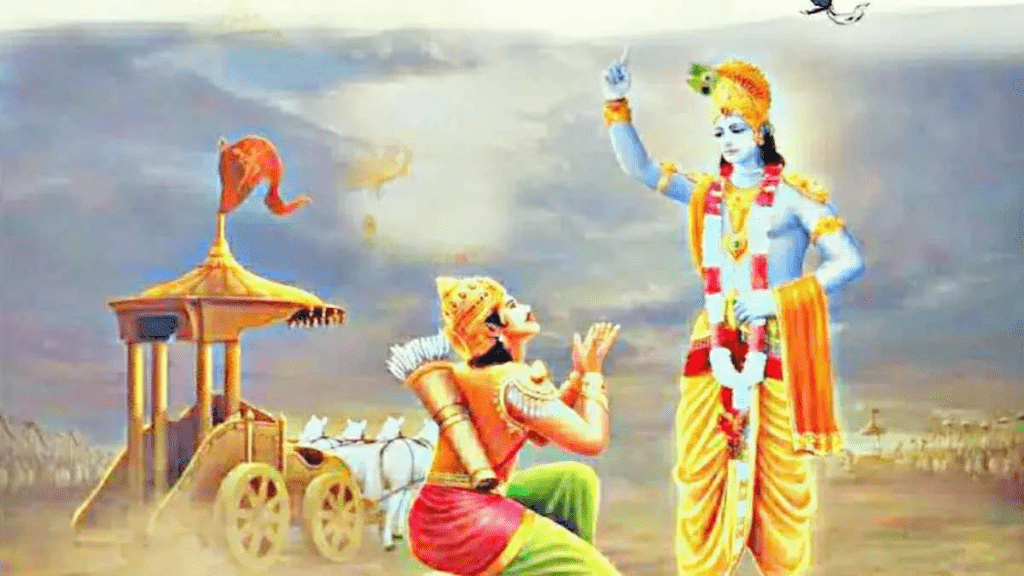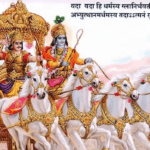Introduction
The Bhagavad Gita, often referred to as the Gita, is a 700-verse Hindu scripture that is part of the Indian epic Mahabharata. It consists of a conversation between Prince Arjuna and the god Krishna, who serves as his charioteer. This sacred text is a profound guide to leading a meaningful and purposeful life, addressing key philosophical and ethical questions. The Gita is divided into 18 chapters, each of which imparts valuable wisdom and insights.
In this blog, we will delve into each of the 18 chapters of the Bhagavad Gita to gain a deeper understanding of what Shri Krishna imparts to Arjuna. We will explore the core teachings, principles, and life lessons that emerge from this ancient scripture.
Let’s embark on this spiritual journey through the Bhagavad Gita, chapter by chapter, and uncover the timeless wisdom it holds.
Chapter 1: Arjuna’s Dilemma
The Bhagavad Gita begins with Arjuna, a skilled warrior and a prince of the Kuru dynasty, facing a profound moral dilemma on the battlefield of Kurukshetra. As the battle is about to commence, he is filled with doubt and anguish about the consequences of the war. He sees his own kith and kin, teachers, and friends on both sides of the battlefield, and the prospect of fighting and killing them overwhelms him. This chapter sets the stage for the teachings to come and illustrates the human experience of doubt and moral conflict. Read more about Chapter 1.
Chapter 2: The Eternal Truth
In the second chapter, Shri Krishna imparts essential wisdom about the eternal nature of the self (Atman) and the impermanence of the physical body. He explains the concept of Dharma, one’s duty, and encourages Arjuna to rise above his doubts and perform his duty as a warrior. This chapter introduces the core principles of the Gita, emphasizing self-realization, detachment from the material world, and the eternal nature of the soul. Read more about Chapter 2.
Chapter 3: The Yoga of Selfless Action
Chapter 3 delves into the concept of Karma Yoga, the yoga of selfless action. Shri Krishna explains the importance of performing one’s duties without attachment to the results. He stresses that selfless action is a means to attain spiritual growth and liberation. This chapter elucidates the practical application of spiritual principles in one’s daily life. Read more about Chapter 3
Chapter 4: Transcendental Knowledge
In the fourth chapter, Shri Krishna reveals the knowledge of the eternal and transcendental truth. He discusses the concept of avatars and how he periodically incarnates to restore Dharma. This chapter highlights the significance of true knowledge and the path to spiritual enlightenment. Read more about Chapter 4
Chapter 5: The Yoga of Renunciation
Chapter 5 emphasizes the importance of renunciation and the renunciation of the fruits of one’s actions. Shri Krishna explains how a self-realized person sees the unity in all beings and acts with equanimity. This chapter expounds on the idea that true renunciation is not merely giving up physical possessions but letting go of attachment to the results of actions.Read more about chapter 5
Chapter 6: The Science of Self-Realization
Chapter 6 is dedicated to the science of self-realization through meditation and self-discipline. Shri Krishna elaborates on the nature of the mind, the importance of controlling one’s thoughts, and the significance of unwavering devotion. This chapter provides insights into the practice of Raja Yoga and the path to self-realization.Read more about Chapter 6.
Chapter 7: Knowledge of the Absolute
In the seventh chapter, Shri Krishna imparts knowledge about the nature of the Absolute. He explains the three gunas (modes of material nature) and the importance of transcending them to attain spiritual realization. This chapter deepens the understanding of the material and spiritual worlds.
Chapter 8: Attaining the Ultimate
Chapter 8 explores the process of attaining the ultimate truth and the concept of the eternal soul merging with the Supreme Being. Shri Krishna describes the path of devotion and meditation as a means to reach the divine. This chapter reveals the path to liberation and the eternal reality beyond the material world.
Chapter 9: The Most Secret Knowledge
Chapter 9 reveals the most secret knowledge, emphasizing the importance of unwavering devotion to the Divine. Shri Krishna explains the significance of bhakti yoga, the yoga of devotion, and the deep connection between the devotee and the Divine. This chapter illustrates the power of sincere and loving devotion.
Chapter 10: The Divine Glories
Chapter 10 elaborates on the divine glories and manifestations of the Supreme. Shri Krishna reveals his various divine forms and explains how all forms and beings originate from him. This chapter emphasizes the omnipresence and omnipotence of the Divine.
Chapter 11: The Vision of the Universal Form
In the eleventh chapter, Arjuna is granted a divine vision by Shri Krishna. He beholds the universal form of the Divine, encompassing all aspects of creation, preservation, and destruction. This chapter offers a profound insight into the all-encompassing nature of the Divine and the mysteries of the universe.
Chapter 12: The Path of Devotion
Chapter 12 delves into the path of devotion and the qualities of a true devotee. Shri Krishna explains the attributes of a sincere devotee and how such devotion leads to spiritual realization. This chapter highlights the significance of devotion and surrender to the Divine.
Chapter 13: The Field and Its Knower
Chapter 13 explores the concepts of the field and its knower, distinguishing between the physical body (the field) and the eternal soul (the knower). Shri Krishna explains the qualities of the soul and its relationship with the material world. This chapter sheds light on the distinction between the perishable and the imperishable.
Chapter 14: The Three Modes of Material Nature
Chapter 14 discusses the three modes of material nature: goodness (sattva), passion (rajas), and ignorance (tamas). Shri Krishna explains how these modes influence human behavior and how one can transcend them to attain spiritual enlightenment. This chapter provides insight into the nature of human actions and their consequences.
Chapter 15: The Eternal Tree
Chapter 15 uses the metaphor of the eternal tree to illustrate the material and spiritual worlds. Shri Krishna describes the eternal nature of the soul’s connection to the Divine and the roots of this tree. This chapter emphasizes the importance of understanding one’s eternal identity and the path to liberation.
Chapter 16: The Divine and Demoniac Natures
Chapter 16 distinguishes between the divine and demoniac natures. Shri Krishna explains the qualities and characteristics of these two natures and how they shape human behavior. This chapter provides valuable insights into the nature of good and evil and the consequences of one’s actions.
Chapter 17: The Three Types of Faith
Chapter 17 categorizes faith into three types based on the influence of the three modes of material nature. Shri Krishna explains the nature of these faiths and their impact on a person’s beliefs and actions. This chapter deepens the understanding of faith and its role in spiritual evolution.
Chapter 18: Conclusion and Liberation
The final chapter, Chapter 18, serves as a conclusion to the teachings of the Bhagavad Gita. Shri Krishna summarizes the key principles and paths discussed throughout the Gita, offering guidance to Arjuna. This chapter addresses the concept of Moksha (liberation) and the importance of understanding one’s Dharma (duty) to attain it.
Conclusion
The Bhagavad Gita, with its 18 chapters, is a profound source of spiritual wisdom and guidance. It covers a wide range of topics, from self-realization to the nature of the Divine, and from the paths of devotion to the qualities that shape human behavior. The Gita’s teachings continue to inspire and enlighten people on their spiritual journeys, providing valuable insights into the art of living a meaningful and purposeful life.
In our exploration of these 18 chapters, we have touched upon the core principles and messages that Shri Krishna imparts to Arjuna. From selfless action and devotion to the nature of the self and the eternal truth, the Bhagavad Gita offers a comprehensive guide to leading a life filled with purpose, wisdom, and spiritual enlightenment.
As you delve deeper into the teachings of the Bhagavad Gita, you will discover the timeless relevance of its wisdom and its potential to transform your understanding of life, purpose, and spirituality. The Gita is not just a sacred scripture; it is a manual for living a life of true fulfillment, inner peace, and spiritual awakening.


